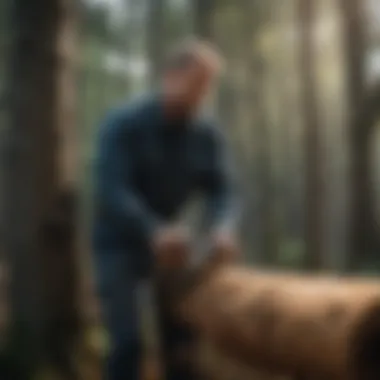Exploring Tree Shearing: Techniques and Benefits


Intro
Tree shearing is a critical process in forest management, merging traditional techniques with modern technology. It serves various purposes, from enhancing tree growth to managing understory vegetation. This article delves into the intricacies of tree shearing, aiming to provide a comprehensive understanding of its techniques, benefits, and guidelines. By examining both historical and contemporary contexts, we highlight the ecological implications and tools utilized throughout the shearing process. The intention is to equip forestry professionals and enthusiasts with valuable insights that promote sustainable practices within the forestry sector.
Overview of Forestry Practices
Definition of Forestry
Forestry refers to the science and practice of managing forests, tree plantations, and related resources. This involves understanding the biology of trees, the ecology of forest ecosystems, and the social and economic factors influencing forest management. Properly managed forests contribute to biodiversity, provide habitats for wildlife, and offer a multitude of ecosystem services.
Importance of Forestry in Ecosystem Management
Forestry plays a vital role in maintaining ecological balance. This forms the backbone of ecosystem management, ensuring that forests function sustainably. The significance of forestry includes, but is not limited to:
- Carbon Sequestration: Forests absorb carbon dioxide, reducing greenhouse gases in the atmosphere, which is essential in the fight against climate change.
- Biodiversity Preservation: Healthy forests support a diverse array of flora and fauna, crucial for ecosystem resilience.
- Soil Conservation: Proper management prevents soil erosion, maintaining soil health for future generations.
- Water Quality Protection: Forests filter pollutants, thereby preserving water quality in nearby rivers and streams.
Sustainable Forest Management
Principles of Sustainable Practices
Sustainable forest management focuses on maintaining and enhancing the economic, social, and environmental values of forests. Key principles include:
- Integrated Management: Combines ecological, social, and economic factors in decision-making.
- Long-term Perspective: Ensures that contributions of forests are preserved for future generations.
- Community Involvement: Engages local communities and stakeholders in the decision-making process.
Techniques in Sustainable Management
Various techniques exist to promote sustainability in forest management, such as:
- Selective Logging: Involves the careful removal of certain trees while preserving the overall structure of the forest.
- Reforestation: Reintroducing trees to areas where the forest has been depleted.
- Agroforestry: Integrating trees into agricultural systems, leading to improved biodiversity and land productivity.
Woodland Stewardship Strategies
Importance of Woodland Stewardship
Woodland stewardship encompasses the responsible management of forest ecosystems. It fosters a symbiotic relationship between landowners and their environments. Effective stewardship contributes to:
- Sustainable Resource Use: Ensuring that forest resources are utilized without depleting them.
- Ecosystem Health: Maintaining biodiversity and resilience within forest ecosystems.
Best Practices for Landowners
Landowners can adopt several best practices to enhance woodland stewardship, including:
- Regular Assessments: Conduct periodic evaluations of forest health.
- Soil Management: Employ practices that promote soil fertility and prevent erosion.
- Fire Management: Implement strategies to control wildfires and promote natural regeneration.
"Sustainable forestry is not just about trees; it is about maintaining the balance between human needs and ecological health."
This holistic approach to managing trees contributes not only to the health of forest ecosystems but also aligns with the broader goals of sustainable development.
Understanding Tree Shearing
Tree shearing is a vital practice in the field of forestry and landscape management. It encompasses various techniques used to manage tree growth effectively. Understanding these techniques is crucial for improving tree health, promoting biodiversity, and maintaining aesthetic values in urban and rural settings. This section delves into the definition of tree shearing and the historical context that has shaped its current applications.
Definition and Overview
Tree shearing refers to the systematic removal of limbs and branches from trees. This technique is implemented primarily to enhance tree form, control growth, and facilitate the health of the tree. Shearing can involve both mechanical and manual methods. The process can prevent overcrowding and minimize competition for resources among trees. An essential aspect of tree shearing is its timing, often performed during the tree's dormant season. This timing reduces stress on the trees and promotes healthier growth in the following seasons.
By integrating proper tree shearing practices, it can significantly improve the overall appearance of landscapes. Furthermore, strategic shearing can lessen the risk of disease and pest infestation, ultimately contributing to the ecological balance of the area. The relevance of understanding tree shearing lies not only in improving solitary trees but also in enhancing the broader ecosystem.
Historical Context
The practice of tree shearing has its roots in traditional forestry techniques that date back centuries. Historically, communities relied on shearing for multiple purposes, including firewood production and creating open resources for agriculture. Trained foresters implemented shearing methods to manage woodlots and enhance growth, reflecting early awareness of sustainable practices.


In the 20th century, as urbanization increased, the aesthetic aspects of tree shearing gained importance. Landscapers began to adopt shearing techniques to create manicured public parks and gardens. This shift highlighted the dual role of tree shearing as both a practical and artistic endeavor. Today, tree shearing is recognized not only for its functional benefits but also as a practice that can help maintain biodiversity in managed environments.
Understanding the history of tree shearing underscores its evolution and significance in modern forest management. The knowledge gathered over time aids forestry professionals in applying these techniques more effectively.
Techniques of Tree Shearing
Tree shearing is a crucial practice in forestry management, impacting both the health of trees and the surrounding ecosystem. The techniques employed in tree shearing vary widely, influencing outcomes related to tree vitality, biodiversity, and aesthetic value. It is essential for forestry professionals to understand the different methods available to ensure effective application according to specific needs.
Mechanical Shearing Methods
Mechanical shearing methods utilize machines equipped with sharp blades to cut and shape trees efficiently. This approach is often preferred in large-scale operations due to its speed and effectiveness. Common machinery includes chainsaws, harvesters, and mulchers, which can handle significant volumes of work in a limited time.
The primary advantage of mechanical shearing is its efficiency. For example, a harvester can shear multiple trees simultaneously, significantly reducing labor costs. Additionally, mechanical methods can often achieve uniformity in tree shaping, which can aid in controlling tree density and promoting healthier growth patterns.
However, there are considerations to keep in mind. The use of machinery raises concerns about soil compaction and damage to surrounding vegetation. Therefore, it is vital to select appropriate equipment and techniques to minimize environmental impact.
Hand Shearing Techniques
Hand shearing techniques, on the other hand, are more labor-intensive and often employed in smaller-scale projects or sensitive environments. Tools such as hand saws, pruners, and loppers are used to carefully choose which branches to cut and how to shape a tree. This method offers a higher degree of precision, allowing for targeted cuts that can significantly enhance the overall health of the tree.
One key benefit of hand shearing is the ability to assess the tree's condition closely. Arborists can identify and remove dead or diseased branches, fostering healthier growth. Hand shearing also minimizes the risk of causing damage to the surrounding ecosystem since it lacks the aggressive nature of mechanical methods.
However, this technique is time-consuming and may not be practical for large-scale operations. It often requires skilled labor, adding to operational costs. Thus, hand shearing is best used when aiming for sustainability and ecological considerations.
Comparative Analysis of Techniques
The choice between mechanical and hand shearing methods significantly affects the outcome of tree management practices. Both techniques have their merits and drawbacks, making it important to analyze the specific context of each situation.
- Efficiency: Mechanical shearing is fast and effective for large areas, while hand shearing demands more time and human resources.
- Precision: Hand shearing allows for precise cuts, tailored to the individual tree's requirements, ideal for urban and diverse landscapes.
- Environmental Impact: Mechanical methods may lead to soil compaction and habitat disruption, while hand shearing generally presents less risk to surrounding flora.
Benefits of Tree Shearing
Tree shearing, while sometimes overlooked, plays a crucial role in sustainable forestry management. Understanding the benefits associated with this practice helps clarify its importance. The advantages of tree shearing can be categorized into three main areas: enhancing tree health, promoting biodiversity, and improving aesthetic appeal. In addressing these benefits, it becomes clear how tree shearing contributes positively to both ecological balance and human enjoyment of natural spaces.
Enhancement of Tree Health
One of the critical benefits of tree shearing is the enhancement of tree health. Regular shearing can effectively remove dead or diseased branches, allowing for better airflow and sunlight penetration. This practice encourages new growth and resilience against pests and diseases. Trees that are periodically sheared are less likely to suffer from overcrowding and competition for resources, which can lead to greater overall vitality. Moreover, trees maintained through shearing can develop a more robust structure, making them less susceptible to wind damage and other environmental stressors. Proper management practices can extend the lifespan of trees and raise their quality, resulting in healthier forests.
Promotion of Biodiversity
Tree shearing also plays a role in promoting biodiversity within forest ecosystems. By managing tree density and promoting a diversity of plant species, shearing can create varied habitats. This diversity supports numerous bird, insect, and animal species that rely on healthy forests for shelter and food. In some cases, shearing can mimic natural disturbances, which is vital for maintaining ecological dynamics. Furthermore, it is essential to recognize that a balanced ecosystem is often more resilient against environmental changes. Thus, shearing contributes to both the immediate survival of various species and the long-term stability of the ecosystem.
"Healthy forests foster rich biodiversity, ensuring the survival of numerous species essential for ecosystem balance."
Improved Aesthetic Appeal
Another significant aspect of tree shearing is its impact on aesthetic appeal. Well-maintained trees contribute to the beauty of landscapes, whether in urban or rural settings. Tree shearing helps maintain a tidy appearance and can encourage desirable growth patterns. Moreover, landscapes with properly sheared trees can create inviting spaces for recreation and tourism, further emphasizing the need for thoughtful forest management. Careful shearing techniques can also allow for the formation of visually striking shapes, enhancing the overall beauty of gardens, parks, and natural reserves. People are often attracted to areas where trees are managed effectively, leading to an increased appreciation for nature.
Ecological Implications of Tree Shearing
Tree shearing has wide-ranging ecological implications that are crucial to understanding within the broader context of forest management. As the practice involves the pruning and trimming of trees, it can lead to several significant effects on the environment. Examining both the positive and negative aspects can provide insights into how tree shearing can be managed more effectively. The focus should remain on its influence on soil health and the local wildlife, two critical components of any ecosystem.
Impact on Soil Health
Tree shearing can influence soil health in various ways. First, when done correctly, shearing promotes better light penetration to the forest floor, which facilitates the growth of understory plants. These plants contribute organic matter to the soil through their leaf litter, enhancing soil structure and fertility.
Moreover, tree shearing can help in nutrient cycling. When branches are trimmed, they can be left on the ground to decompose. This process returns essential nutrients back to the soil, which benefits surrounding trees and plants. However, improper shearing may lead to soil compaction or erosion, especially in steep areas. It is vital to use proper techniques to prevent such adverse effects, ensuring that the soil remains healthy and capable of sustaining diverse plant life.
In summary, thoughtful tree shearing can aid in optimizing soil conditions, promoting vitality in forest ecosystems.
Effect on Local Wildlife
Tree shearing significantly affects local wildlife, which may thrive or suffer depending on how the practice is carried out. The removal of branches can open up habitats, allowing more sunlight to reach the forest floor. This change can support various wildlife species, as it encourages the growth of grasses and shrubs that serve as food sources.


However, extensive shearing might also remove essential nesting sites and shelters for birds and other animals. Maintaining a balance is crucial. Responsible shearing techniques should include leaving certain areas untouched, allowing wildlife populations to persist. This notion aligns with sustainable forest management principles that prioritize biodiversity.
"A true sign of a healthy ecosystem is its ability to maintain a balance between tree management and wildlife protection."
Furthermore, the timing of shearing is key to minimizing disturbances to breeding seasons for local species. Educating practitioners about these nuances is vital to mitigate negative impacts on wildlife.
Tools and Equipment for Tree Shearing
Tree shearing is a crucial aspect of maintaining the health and aesthetic appeal of trees. The correct tools and equipment facilitate this process by ensuring efficiency and effectiveness. This section explores the essential tools required for tree shearing, along with safety considerations that protect both the workers and the environment.
Essential Tools Required
The tools for tree shearing are varied but can be categorized based on their use and proficiency required. Understanding each one's role is fundamental to enhance productivity and ensure proper care for the trees.
- Hand Pruners: These are basic tools that are indispensable for minor shearing tasks. Hand pruners offer precision and control, making them suitable for smaller branches.
- Loppers: Used for thicker branches, loppers can efficiently prune tree limbs that are out of reach for hand pruners. They come in various sizes and designs to cater to different needs.
- Tree Saws: When dealing with larger branches, a tree saw becomes necessary. It allows for clean cuts without damaging the surrounding bark.
- Chainsaws: For extensive shearing tasks or larger trees, chainsaws offer speed and power. However, they require greater skill and safety precautions.
- Pole Saws: These tools extend reach considerably, enabling farmers or forestry professionals to trim high branches without ladders.
- Mechanical Trimers: For substantial operations, mechanical trimmers may be employed. They provide efficiency when large areas are being sheared, reducing manual labor.
It's crucial to consider the specific needs of the area and type of trees being managed. Assessing the age and health of trees can also affect the choice of equipment. Proper maintenance of these tools is vital to ensure longevity and optimal performance.
Safety Equipment Considerations
Safety should be paramount during any shearing activity. The tools used can pose risks such as cuts, falls, or in some cases, damages to the surrounding environment. Proper safety equipment minimizes these risks.
- Protective Eyewear: This prevents debris from getting into the eyes while cutting.
- Gloves: Sturdy, cut-resistant gloves protect the hands during handling sharp tools.
- Hearing Protection: Chainsaws and trimmers can produce harmful noise levels, making hearing protection important.
- Hard Hats: When working under trees, hard hats can protect against falling branches.
- Safety Boots: Footwear should be sturdy and slip-resistant to deal with uneven ground conditions.
Moreover, user education on safe tool operation is vital. Training sessions and safety meetings can enhance understanding of both tool usage and potential hazards associated with tree shearing.
"Every tree shearing task becomes easier and safer with the right tools and safety gear."
In essence, investing in the right tools and prioritizing safety equipment not only ensures effective tree care but also supports sustainability efforts in forestry management.
Best Practices for Effective Tree Shearing
Effective tree shearing is not just about cutting branches; it requires an understanding of specific techniques, timing, and methods that minimize stress on trees. Following best practices is crucial for ensuring the safety and health of trees, while also optimizing the aesthetic and ecological outcomes.
Timing and Frequency
The timing and frequency of tree shearing are vital elements that influence the overall health of trees. Shearing should typically coincide with the dormant season, which is usually late fall to early spring. During this period, trees expend less energy on growth and can better cope with the stress of pruning. This seasonal approach allows for quicker recovery and minimizes the risk of pest infestation.
Moreover, the frequency of shearing should be dictated by the species of tree and its growth rate. Fast-growing species like willows may require more frequent shearing compared to slower-growing types, such as oaks. Some general recommendations include:
- Annual Shearing - Ideal for fast-growing trees to maintain desired shapes.
- Biannual Shearing - Suitable for moderate growth species to encourage healthy branching.
- Triennial Shearing - Appropriate for slow-growing trees, focusing on maintenance without excessive cutting.
Proper timing and frequency ensure that the trees remain strong and healthy while achieving the aesthetic goals of shearing.
Methods to Minimize Stress on Trees
Minimizing stress on trees during the shearing process can greatly improve outcomes. Implementing gentler techniques and being mindful of the cutting methods can ensure that trees recover quickly and remain vibrant. Key practices to consider include:
- Avoiding Over-Pruning: Cutting too much foliage in one session can weaken trees. Aim to remove no more than 25% of the foliage to maintain energy reserves.
- Using Appropriate Tools: Sharp and clean tools can make precise cuts, reducing damage to the bark and helping the tree heal faster. For larger branches, leverage tools like a pole saw or chainsaw, while handheld pruners are effective for smaller branches.
- Cutting at the Right Angle: Making cuts at a 45-degree angle can help water run off, preventing rot, and encouraging optimal growth patterns.
- Observing Tree Health: Pay attention to the tree's condition before and after shearing. Any signs of distress should prompt reevaluation of techniques and practices to ensure proper care is taken.
In summary, following best practices in tree shearing, with a strong emphasis on timing, frequency, and stress-minimizing methods can greatly enhance tree health and overall success in forest management.
Tree Shearing in Different Environments
Understanding how tree shearing interacts with various environments is critical. Environmental conditions can significantly influence the effectiveness and outcomes of tree shearing practices. Different locations present unique challenges and advantages that dictate the techniques applied and the level of community involvement necessary. This section will delve into urban settings compared to rural applications, followed by the adaptations needed for various forest types.
Urban vs. Rural Applications
Tree shearing in urban areas demands a different approach than what may be required in rural settings. In urban environments, trees are often situated near buildings, sidewalks, and overhead utilities. Because of this, careful planning and precision are vital. Common practices like crown reduction and canopy thinning become crucial to ensure healthy growth while preventing harm to nearby structures. Additionally, public safety must be prioritized to manage risks of falling branches or large tree failures.
On the other hand, rural applications of tree shearing often focus on enhancing the overall health of forest stands or facilitating agricultural needs. Here, there may be more room for extensive shearing methods, and the impact on surrounding wildlife is closely monitored. Rural areas generally allow for broader shearing practices without immediate proximity to human structures. This enables the promotion of healthier ecosystems, as open areas created by shearing can allow for new growth and foster biodiversity.
Some key considerations for both urban and rural tree shearing practices include:


- Urban: Precise cutting techniques, public education on tree health, and safety considerations due to human proximity.
- Rural: Ecosystem impacts, compatibility with agricultural practices, and longer-term management strategies.
Adaptations for Various Forest Types
Different forest types require adaptations in tree shearing strategies to achieve optimal outcomes. First, temperate forests often allow for more robust shearing because species in these forests can generally handle the stress of heavy pruning. This can lead to enhanced vigor and improved canopy structure. In contrast, in tropical forests, careful selection of tree species is needed, as some may be more sensitive to shearing.
Next, coniferous forests may require specific shearing techniques to maintain the necessary spacing and health among densely packed trees. This helps mitigate risks of disease spread. The removal of lower branches can also support wildlife habitat by creating open space underneath for smaller species.
Finally, mixed hardwood forests often benefit from selective thinning through shearing. By targeting specific trees for removal, forest density can be managed, allowing remaining trees to have access to light and nutrients. Adaptation in these environments considers not just the trees themselves but contributes to the overall ecosystem health.
To summarize, tree shearing should consider the local environment whether in urban or rural areas, and specific techniques need to be adapted based on forest type. Recognizing these factors leads to successful shearing practices that promote the sustainability of our forests.
Challenges in Tree Shearing
Tree shearing, while beneficial, also comes with a range of challenges that can hinder its effectiveness and sustainability in forest management. Understanding these challenges is essential for ensuring that the practice is implemented in a manner that is both environmentally responsible and focused on long-term forest health. The obstacles faced can vary based on location, regulations, and the specific methods used for shearing. By addressing these challenges, forestry professionals can enhance their strategies and knowledge in managing tree populations more effectively.
Common Obstacles Faced
Tree shearing involves several obstacles that individuals and organizations may encounter:
- Technical Challenges: The skill and experience level required for effective shearing can vary widely. Often, inexperienced personnel may produce uneven cuts, leading to potential harm to the tree's health. Poor techniques during shearing can result in stunted growth or even tree death.
- Logistical Issues: Accessing remote forest areas where shearing is needed can be problematic. Infrastructure limitations, such as poor road conditions or lack of transportation, can delay projects and increase costs.
- Cost Constraints: Financial limitations can restrict the choice of tools or equipment. High-quality shearing equipment may represent a significant investment, which can be prohibitive for smaller organizations or community initiatives.
- Weather Conditions: Adverse weather can impact scheduling and the effectiveness of shearing. Windy or rainy conditions may make it unsafe or ineffective to carry out shearing tasks.
Environmental Regulations and Compliance
In addition to practical challenges, navigating environmental regulations presents its own set of difficulties. Tree shearing activities are subject to various local, state, and federal laws intended to protect natural ecosystems. Compliance with these regulations involves understanding:
- Permitting Requirements: Specific permits may be required before commencing tree shearing. This process can be time-consuming and may involve detailed environmental impact assessments.
- Protective Policies: Certain regions have protected species that could be affected by shearing. Understanding and adhering to these protected status rules is crucial for sustainable forestry practices.
- Monitoring and Reporting: Many regulations mandate ongoing monitoring and reporting of the effects of shearing activities on local ecosystems. This requirement can be a cumbersome but necessary part of the shearing process.
Overall, addressing both common obstacles and regulatory compliance is vital for promoting effective tree shearing. Engaging with these challenges thoughtfully can significantly enhance the success of forestry initiatives.
Community Involvement in Tree Shearing
Community involvement plays a crucial role in the practice of tree shearing. Engaging local communities not only enhances the effectiveness of shearing initiatives but also raises awareness about forest management and conservation. The benefits of community participation in tree shearing are numerous. It fosters a sense of ownership among residents and creates a collective effort towards the health of local green spaces. Moreover, the involvement of community members encourages educational opportunities that can lead to more sustainable practices in tree management.
Public Awareness and Education
Educating the public about tree shearing is a fundamental step in ensuring the success of such initiatives. When people understand the significance of tree health and the role of shearing in maintaining it, they are more likely to engage in supportive behaviors. Awareness programs can include workshops, community talks, and informational campaigns. These should highlight not only the practical aspects of tree shearing, like the techniques and tools used, but also the broader environmental benefits, such as enhanced biodiversity and improved aesthetics in their neighborhoods.
Outreach efforts can leverage social media platforms like Facebook and local events to spread the message effectively. Using visual aids, such as before-and-after photos, can illustrate the positive impacts of shearing, making it more relatable to the community. Involving schools can also be effective, as students can learn about tree shearing through hands-on activities, fostering an early appreciation for environmental stewardship.
Volunteer Programs and Initiatives
Volunteer programs are essential for mobilizing community action in tree shearing. These programs can organize events where local residents gather to shear trees in designated areas, promoting teamwork and shared responsibility. Such initiatives can attract varying age groups, strengthening community bonds while improving local environments.
Successful volunteer programs often include:
- Regular Events: Scheduling tree shearing days can build routine participation.
- Training Sessions: Providing instruction on techniques and safety ensures that volunteers feel equipped to contribute effectively.
- Recognition: Acknowledging the efforts of volunteers through certificates or public appreciation helps to cement their importance to the community.
Furthermore, partnerships with local organizations can enhance these programs. Collaborating with schools, nonprofits, and environmental groups increases resources and outreach capabilities. By creating meaningful volunteer opportunities, communities can not only improve their local landscapes but also instill a sense of pride and accountability among participants.
Future Trends in Tree Shearing
As the field of forestry evolves, tree shearing techniques also undergo significant transformation. The future trends in this area reflect both the needs of the environment and advancements in technology. Understanding these trends is critical for forestry professionals who seek to implement effective and sustainable practices. It ensures that the long-term health of forests is maintained while also embracing the latest methodologies.
Technological Advancements
The influence of technology on tree shearing cannot be overstated. Innovations in machinery and tools are reshaping how professionals approach tree care. Automated shearing equipment, such as remote-controlled devices and drones, improve efficiency and safety. These tools reduce the physical strain on workers and allow for more precise cuts, which is essential for promoting tree health.
Additionally, software solutions for planning and monitoring tree shearing operations are gaining traction. These tools can assist in scheduling work with optimal timing and can keep track of the health of trees over time. With data analytics, forestry professionals can make informed decisions based on real-time information.
"Advancements in technology will redefine tree shearing practices, focusing not only on efficiency but also on sustainability."
Sustainable Practices on the Rise
The growing awareness of environmental issues is driving the adoption of sustainable practices in tree shearing. These practices are crucial for promoting ecological balance and conserving biodiversity. One trend is the integration of permaculture principles, where shearing techniques complement natural ecosystems rather than disrupt them.
Furthermore, there is an increasing emphasis on organic methods that reduce reliance on synthetic chemicals for pest control. Efficient shearing can also minimize carbon footprints by reducing the need for fuel-intensive machinery.
The rise of community initiatives for tree care also highlights a shift towards more sustainable practices. These programs often encourage local volunteer participation, fostering a sense of stewardship over shared green spaces.







